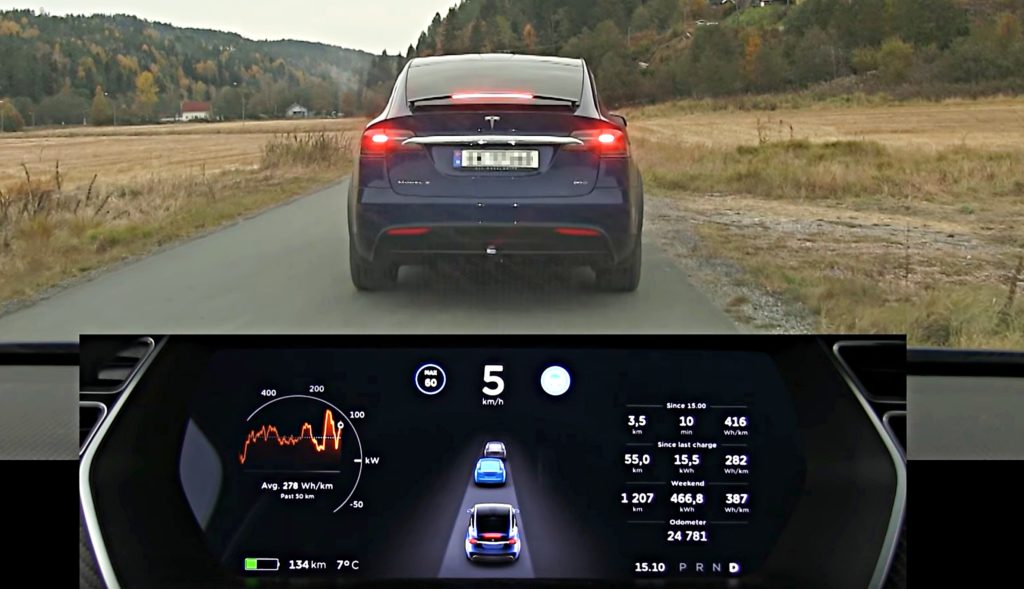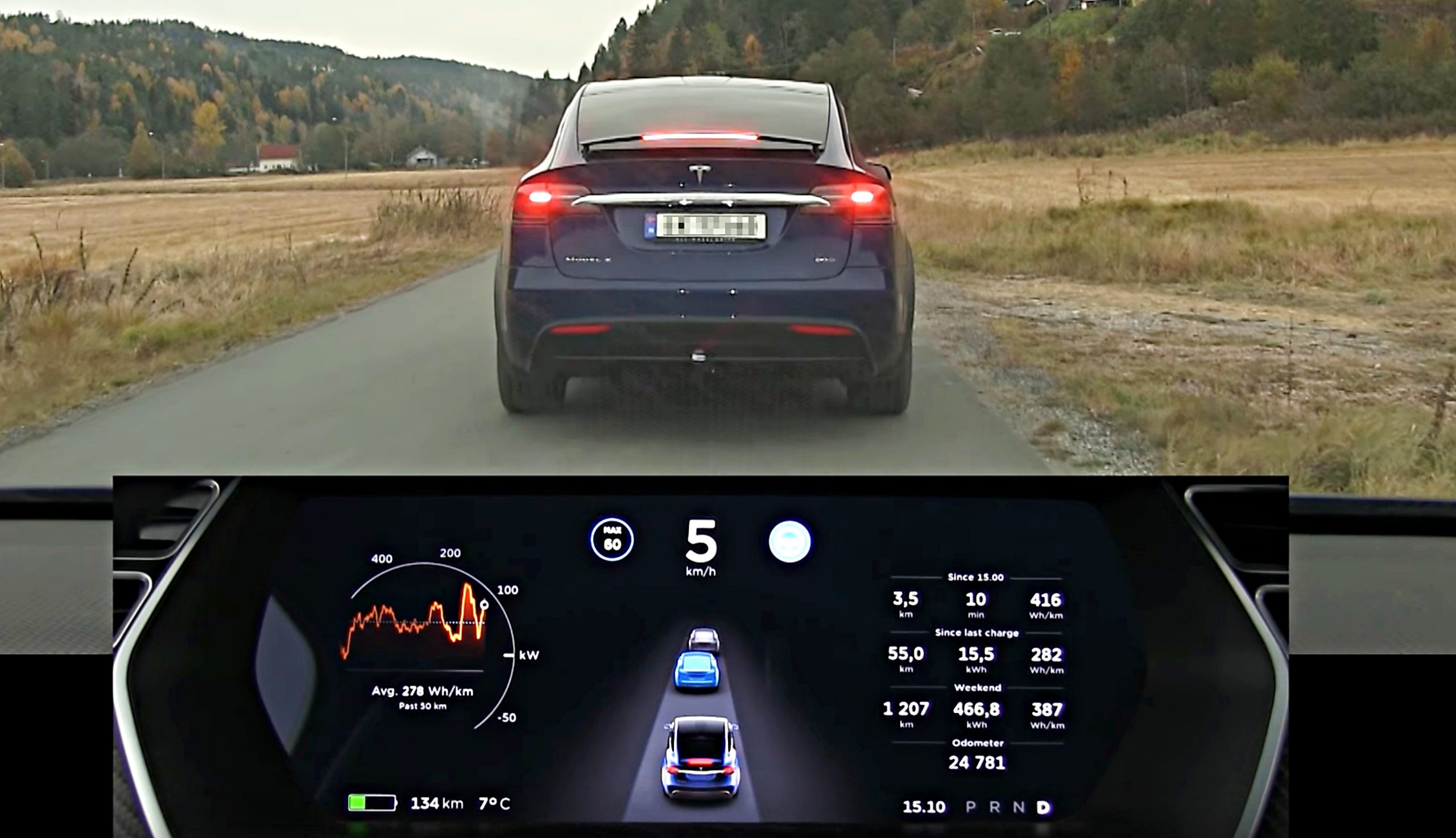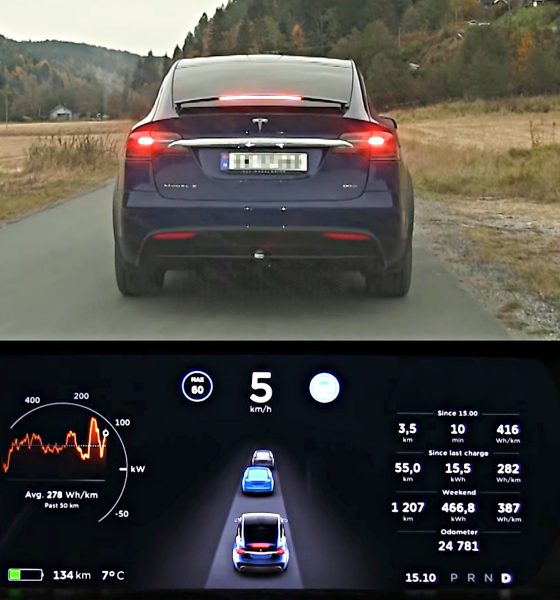In its latest report on automatic emergency braking (AEB) standards for automakers, the National Highway Traffic Safety Administration (NHTSA) and the Insurance Institute for Highway Safety (IIHS) have announced that Tesla is one of only four manufacturers so far that has reached the goal of supplying AEB on more than half of its produced vehicles in model year 2017. This first manufacturer’s report on the voluntary crash avoidance standard lists four manufacturers offering AEB on more than half and another seven with the tech on more than thirty percent of their 2017 model year vehicles.
The initiative was first announced in 2015 with a total of ten automakers on board, including Tesla. Other automakers at that time included Audi, BMW, Ford, General Motors, Mazda, Mercedes-Benz, Toyota, Volkswagen, and Volvo. A year later, an additional ten manufacturers joined. The initiative’s goal is to get manufacturer’s voluntarily on board to make forward collision warning (FCW) systems and automatic emergency braking standard equipment on all vehicles manufactured by September 1, 2022, about the time that model year 2023 vehicles would be entering production. The initiative further pushes for all trucks in the medium-duty sector (8,501 to 10,000 pounds gross vehicle weight) to meet the same standard by 2025.
Recently, manufacturers submitted their first yearly progress reports to the IIHS-NHTSA consortium for vehicles manufactured between September 1, 2016 and August 31, 2017 for the U.S. market. Tesla had the largest proportion of its vehicles including the technology for 2017, with all but only a handful of manufactured vehicles having AEB and FCW. This despite many having AEB deactivated for a portion of the year due to glitches with its sensitivity levels. The feature was reactivated in late April and early May as a software update.
For reference, the IIHS-NHTSA report states that Consumer Reports, which assists in monitoring progress towards compliance with the initiative, found that only 19 percent of 2017 model year vehicles include AEB and FCW as standard equipment. Most of those vehicles, like the Model S and Model X being reported by Tesla, are classified as luxury vehicles by price point.
The IIHS and NHTSA estimate that if the commitment by manufacturers to meet the initiative’s standards are met by 2025, a total of 28,000 crashes and 12,000 injuries will be prevented. Total commitment so far from manufacturers in the U.S. market account for over 99 percent of the vehicles sold in the country.

Tesla Model X response test for Autopilot vehicle detection [Credit: Bjørn Nyland]
Systems conforming with the vehicle standard must come with FCW that meets 2 of the 3 NHTSA 5-Star Safety Ratings’ requirements and AEB that earns at least an “Advanced” rating from the IIHS. The four complying automakers who’ve met the standard in more than fifty percent of manufactured 2017 models include Audi (73%), Mercedes-Benz (96%), and Volvo (68%) alongside Tesla (99.8%).
Other manufacturers have lower numbers, but a fast-growing commitment to the standard. Toyota at 56 percent accounts for the largest total volume of vehicles equipped to meet the initiative’s requirements with General Motors, at 20 percent, following closely behind. Lowest on the list of compliance were Fiat Chrysler, Ford, Hyundai, Kia, and Mitsubishi. Of luxury makes, only Jaguar Land Rover and Porsche don’t offer the technologies at all in 2017 model year vehicles counted.

News
Tesla FSD fleet is nearing 7 billion total miles, including 2.5 billion city miles
As can be seen on Tesla’s official FSD webpage, vehicles equipped with the system have now navigated over 6.99 billion miles.

Tesla’s Full Self-Driving (Supervised) fleet is closing in on almost 7 billion total miles driven, as per data posted by the company on its official FSD webpage.
These figures hint at the massive scale of data fueling Tesla’s rapid FSD improvements, which have been quite notable as of late.
FSD mileage milestones
As can be seen on Tesla’s official FSD webpage, vehicles equipped with the system have now navigated over 6.99 billion miles. Tesla owner and avid FSD tester Whole Mars Catalog also shared a screenshot indicating that from the nearly 7 billion miles traveled by the FSD fleet, more than 2.5 billion miles were driven inside cities.
City miles are particularly valuable for complex urban scenarios like unprotected turns, pedestrian interactions, and traffic lights. This is also the difference-maker for FSD, as only complex solutions, such as Waymo’s self-driving taxis, operate similarly on inner-city streets. And even then, incidents such as the San Francisco blackouts have proven challenging for sensor-rich vehicles like Waymos.
Tesla’s data edge
Tesla has a number of advantages in the autonomous vehicle sector, one of which is the size of its fleet and the number of vehicles training FSD on real-world roads. Tesla’s nearly 7 billion FSD miles then allow the company to roll out updates that make its vehicles behave like they are being driven by experienced drivers, even if they are operating on their own.
So notable are Tesla’s improvements to FSD that NVIDIA Director of Robotics Jim Fan, after experiencing FSD v14, noted that the system is the first AI that passes what he described as a “Physical Turing Test.”
“Despite knowing exactly how robot learning works, I still find it magical watching the steering wheel turn by itself. First it feels surreal, next it becomes routine. Then, like the smartphone, taking it away actively hurts. This is how humanity gets rewired and glued to god-like technologies,” Fan wrote in a post on X.
News
Tesla starts showing how FSD will change lives in Europe
Local officials tested the system on narrow country roads and were impressed by FSD’s smooth, human-like driving, with some calling the service a game-changer for everyday life in areas that are far from urban centers.

Tesla has launched Europe’s first public shuttle service using Full Self-Driving (Supervised) in the rural Eifelkreis Bitburg-Prüm region of Germany, demonstrating how the technology can restore independence and mobility for people who struggle with limited transport options.
Local officials tested the system on narrow country roads and were impressed by FSD’s smooth, human-like driving, with some calling the service a game-changer for everyday life in areas that are far from urban centers.
Officials see real impact on rural residents
Arzfeld Mayor Johannes Kuhl and District Administrator Andreas Kruppert personally tested the Tesla shuttle service. This allowed them to see just how well FSD navigated winding lanes and rural roads confidently. Kruppert said, “Autonomous driving sounds like science fiction to many, but we simply see here that it works totally well in rural regions too.” Kuhl, for his part, also noted that FSD “feels like a very experienced driver.”
The pilot complements the area’s “Citizen Bus” program, which provides on-demand rides for elderly residents who can no longer drive themselves. Tesla Europe shared a video of a demonstration of the service, highlighting how FSD gives people their freedom back, even in places where public transport is not as prevalent.
What the Ministry for Economic Affairs and Transport says
Rhineland-Palatinate’s Minister Daniela Schmitt supported the project, praising the collaboration that made this “first of its kind in Europe” possible. As per the ministry, the rural rollout for the service shows FSD’s potential beyond major cities, and it delivers tangible benefits like grocery runs, doctor visits, and social connections for isolated residents.
“Reliable and flexible mobility is especially vital in rural areas. With the launch of a shuttle service using self-driving vehicles (FSD supervised) by Tesla in the Eifelkreis Bitburg-Prüm, an innovative pilot project is now getting underway that complements local community bus services. It is the first project of its kind in Europe.
“The result is a real gain for rural mobility: greater accessibility, more flexibility and tangible benefits for everyday life. A strong signal for innovation, cooperation and future-oriented mobility beyond urban centers,” the ministry wrote in a LinkedIn post.
News
Tesla China quietly posts Robotaxi-related job listing
Tesla China is currently seeking a Low Voltage Electrical Engineer to work on circuit board design for the company’s autonomous vehicles.

Tesla has posted a new job listing in Shanghai explicitly tied to its Robotaxi program, fueling speculation that the company is preparing to launch its dedicated autonomous ride-hailing service in China.
As noted in the listing, Tesla China is currently seeking a Low Voltage Electrical Engineer to work on circuit board design for the company’s autonomous vehicles.
Robotaxi-specific role
The listing, which was shared on social media platform X by industry watcher @tslaming, suggested that Tesla China is looking to fill the role urgently. The job listing itself specifically mentions that the person hired for the role will be working on the Low Voltage Hardware team, which would design the circuit boards that would serve as the nervous system of the Robotaxi.
Key tasks for the role, as indicated in the job listing, include collaboration with PCB layout, firmware, mechanical, program management, and validation teams, among other responsibilities. The role is based in Shanghai.
China Robotaxi launch
China represents a massive potential market for robotaxis, with its dense urban centers and supportive policies in select cities. Tesla has limited permission to roll out FSD in the country, though despite this, its vehicles have been hailed as among the best in the market when it comes to autonomous features. So far, at least, it appears that China supports Tesla’s FSD and Robotaxi rollout.
This was hinted at in November, when Tesla brought the Cybercab to the 8th China International Import Expo (CIIE) in Shanghai, marking the first time that the autonomous two-seater was brought to the Asia-Pacific region. The vehicle, despite not having a release date in China, received a significant amount of interest among the event’s attendees.










